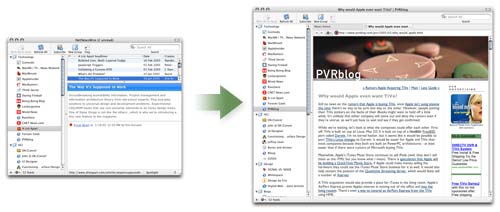RSS, Its Overload, and the Web Browser 03-01-2005
As the adoption rate of RSS and news aggregators increases it is interesting to see how people’s use of the Web changes because of this simple technology. Although, are we approaching information overload? Is this a technology which average users can use? And more importantly, does the Web browser need to change to incorporate this new method of Web browsing.
Handling the Overload
As I sit here typing this I currently have 251 unread articles in my news aggregator. More often than not I end up hitting the Mark All as Read button at the end of the day. Not because I’m not interested in those articles but more so that there is a lot of noise. The news aggregator acts as an aggregator of link aggregators, so you get the point.
How can we cut through the noise and get at the news which interests us. This is a problem I always think about when I hit that Mark All as Read button. Because I constantly think I’m passing by a good article which would be worthwhile for me to read. If Apple Mail can successfully filter out junk mail based on my tastes why can’t a similar method be employed to solve the RSS glut problem? Through analyzing the articles which you do read it can build a profile of your tastes and highlight those articles so you don’t miss a beat on what you like. Granted, I may need to investigate the essence of how a Bayesian filtering system works. This seems like a next logical step and I’m surprised I’ve yet to see any of the major news aggregators implement it.
RSS for the Rest of Them
There has been talk about the methods by which a user subscribes to an RSS feed. From a user experience standpoint it is quite pitiful. The typical user does not know what XML is nor do they know what it looks like or what to do with it. Upon clicking an RSS link the user is presented with what seems to be giberish and is provided with no direction on how to use what they have been presented with. Method such as the feed:// protocol and plugins have attempted to solve this problem. But these still do not make reading and subscribing to RSS as easy as it should be. Total integration with the Web browser may be a better alternative.
Fitting in the Web Browser
The only reason I’m leaning more towards the Web browser as the RSS aggregator is because of the realization of how I use my own news aggregator. Originally, I had a few subscriptions and relegated my news aggregator to a small window, shown in Figure 1, which I checked occasionally. Over time I have expanded the news aggregator to a size larger than my Web browser window. I began to more frequently use my news aggregator as a Web browser, even downloading files and checking email in it.

Figure 1. Progression of the News Aggregator
FireFox has limited RSS capabilities and Apple’s forthcoming Safari RSS doesn’t seem to go all the way either, for me at least. But, I do think these implementations are a great simple way to get average users into the RSS technology. So this does leave an open window for the current news aggregators who will continue to innovate through things such as Podcasting and features for advanced users.